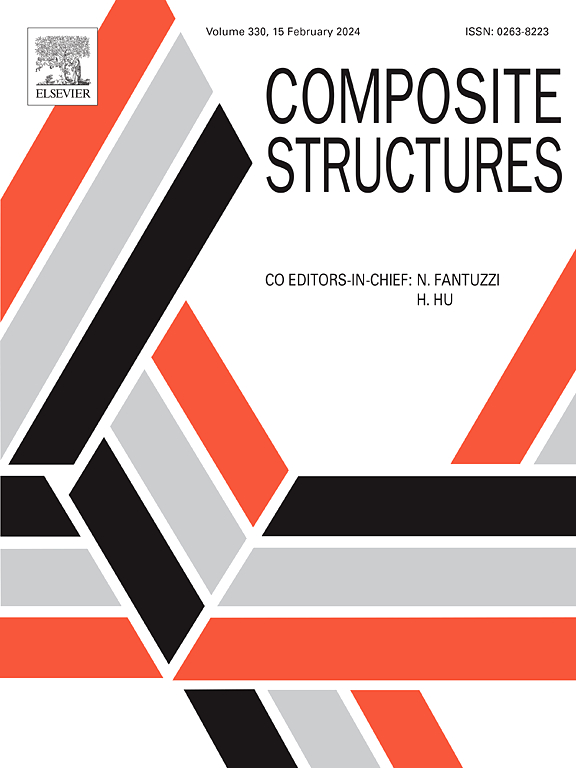A decoupled bend–tension–shear coarse grained model for staggered structures
IF 6.3
2区 材料科学
Q1 MATERIALS SCIENCE, COMPOSITES
引用次数: 0
Abstract
Biomaterials like teeth, bone, and nacre have developed curved geometry and staggered structures, with remarkable mechanical properties attracting plenty of theoretical and numerical works. For these brick–mortar materials, the coupling between bending, stretching, and shearing deformations is inevitable under transverse loading and remains to be explored. In this work, we propose a decoupled bend–tension–shear (d-BTS) coarse grained model for staggered structures, using node displacements only as the basic variables. The bending and stretching deformations of bricks are modeled by two independent sets of springs tied together by Lagrange multipliers, leading to improved computation efficiency. This model may reduce to a minimal model with the least number of spring nodes characterizing the coupling between bending, stretching, and shearing deformations, analogous to the widely accepted tension–shear-chain (TSC) minimal model developed for shear-lag deformation in staggered structures. d-BTS model is validated with several examples confirmed by finite element calculations. The model is used to simulate the three-point bending tests, revealing the important contribution of bending to shear strain and the nontrivial roles of break-matrix on bending rigidity. d-BTS model presents a simple and efficient tool to investigate the toughness and strength of staggered structures in large scales when subjected to bending and stretching.
交错结构的弯曲-拉伸-剪切解耦粗粒模型
牙、骨、珠质等生物材料已经发展出弯曲几何和交错结构,具有显著的力学性能,吸引了大量的理论和数值研究。对于这些砖砂浆材料,在横向荷载作用下,弯曲、拉伸和剪切变形之间的耦合是不可避免的,有待进一步研究。在这项工作中,我们提出了一种解耦的弯曲-拉伸-剪切(d-BTS)粗粒度模型,用于交错结构,仅使用节点位移作为基本变量。通过拉格朗日乘法器将两组独立的弹簧组合在一起来模拟砖块的弯曲和拉伸变形,从而提高了计算效率。该模型可以简化为具有最少数量的弹簧节点的最小模型,表征弯曲、拉伸和剪切变形之间的耦合,类似于广泛接受的用于交错结构剪切滞后变形的张力-剪切链(TSC)最小模型。通过有限元计算验证了d-BTS模型的正确性。利用该模型模拟了三点弯曲试验,揭示了弯曲对剪切应变的重要贡献以及断裂矩阵对弯曲刚度的重要作用。d-BTS模型为研究大尺度交错结构在弯曲和拉伸作用下的韧性和强度提供了一种简单有效的工具。
本文章由计算机程序翻译,如有差异,请以英文原文为准。
求助全文
约1分钟内获得全文
求助全文
来源期刊

Composite Structures
工程技术-材料科学:复合
CiteScore
12.00
自引率
12.70%
发文量
1246
审稿时长
78 days
期刊介绍:
The past few decades have seen outstanding advances in the use of composite materials in structural applications. There can be little doubt that, within engineering circles, composites have revolutionised traditional design concepts and made possible an unparalleled range of new and exciting possibilities as viable materials for construction. Composite Structures, an International Journal, disseminates knowledge between users, manufacturers, designers and researchers involved in structures or structural components manufactured using composite materials.
The journal publishes papers which contribute to knowledge in the use of composite materials in engineering structures. Papers deal with design, research and development studies, experimental investigations, theoretical analysis and fabrication techniques relevant to the application of composites in load-bearing components for assemblies, ranging from individual components such as plates and shells to complete composite structures.
 求助内容:
求助内容: 应助结果提醒方式:
应助结果提醒方式:


